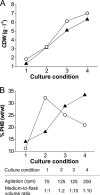Effects of aeration on the synthesis of poly(3-hydroxybutyrate) from glycerol and glucose in recombinant Escherichia coli
- PMID: 20080998
- PMCID: PMC2838013
- DOI: 10.1128/AEM.02706-09
Effects of aeration on the synthesis of poly(3-hydroxybutyrate) from glycerol and glucose in recombinant Escherichia coli
Abstract
Bioreactor cultures of Escherichia coli recombinants carrying phaBAC and phaP of Azotobacter sp. FA8 grown on glycerol under low-agitation conditions accumulated more poly(3-hydroxybutyrate) (PHB) and ethanol than at high agitation, while in glucose cultures, low agitation led to a decrease in PHB formation. Cells produced smaller amounts of acids from glycerol than from glucose. Glycerol batch cultures stirred at 125 rpm accumulated, in 24 h, 30.1% (wt/wt) PHB with a relative molecular mass of 1.9 MDa, close to that of PHB obtained using glucose.
Figures


Similar articles
-
Redox driven metabolic tuning: carbon source and aeration affect synthesis of poly(3-hydroxybutyrate) in Escherichia coli.Bioeng Bugs. 2010 Jul-Aug;1(4):291-5. doi: 10.4161/bbug.1.4.12103. Epub 2010 Apr 15. Bioeng Bugs. 2010. PMID: 21327064 Free PMC article.
-
Elimination of D-lactate synthesis increases poly(3-hydroxybutyrate) and ethanol synthesis from glycerol and affects cofactor distribution in recombinant Escherichia coli.Appl Environ Microbiol. 2010 Nov;76(22):7400-6. doi: 10.1128/AEM.02067-10. Epub 2010 Sep 24. Appl Environ Microbiol. 2010. PMID: 20870794 Free PMC article.
-
Effects of granule-associated protein PhaP on glycerol-dependent growth and polymer production in poly(3-hydroxybutyrate)-producing Escherichia coli.Appl Environ Microbiol. 2007 Dec;73(24):7912-6. doi: 10.1128/AEM.01900-07. Epub 2007 Oct 26. Appl Environ Microbiol. 2007. PMID: 17965215 Free PMC article.
-
Poly(3-hydroxybutyrate) synthesis from glycerol by a recombinant Escherichia coli arcA mutant in fed-batch microaerobic cultures.Appl Microbiol Biotechnol. 2008 Jan;77(6):1337-43. doi: 10.1007/s00253-007-1255-7. Epub 2007 Nov 22. Appl Microbiol Biotechnol. 2008. PMID: 18034236
-
The role of short-chain conjugated poly-(R)-3-hydroxybutyrate (cPHB) in protein folding.Int J Mol Sci. 2013 May 23;14(6):10727-48. doi: 10.3390/ijms140610727. Int J Mol Sci. 2013. PMID: 23702844 Free PMC article. Review.
Cited by
-
Microbubble assisted polyhydroxybutyrate production in Escherichia coli.BMC Res Notes. 2016 Jul 9;9:338. doi: 10.1186/s13104-016-2145-9. BMC Res Notes. 2016. PMID: 27393560 Free PMC article.
-
Modeling and optimization of poly(3hydroxybutyrate-co-3hydroxyvalerate) production from cane molasses by Azohydromonas lata MTCC 2311 in a stirred-tank reactor: effect of agitation and aeration regimes.J Ind Microbiol Biotechnol. 2012 Jul;39(7):987-1001. doi: 10.1007/s10295-012-1102-4. Epub 2012 Feb 24. J Ind Microbiol Biotechnol. 2012. PMID: 22361743
-
Redox driven metabolic tuning: carbon source and aeration affect synthesis of poly(3-hydroxybutyrate) in Escherichia coli.Bioeng Bugs. 2010 Jul-Aug;1(4):291-5. doi: 10.4161/bbug.1.4.12103. Epub 2010 Apr 15. Bioeng Bugs. 2010. PMID: 21327064 Free PMC article.
-
Elimination of D-lactate synthesis increases poly(3-hydroxybutyrate) and ethanol synthesis from glycerol and affects cofactor distribution in recombinant Escherichia coli.Appl Environ Microbiol. 2010 Nov;76(22):7400-6. doi: 10.1128/AEM.02067-10. Epub 2010 Sep 24. Appl Environ Microbiol. 2010. PMID: 20870794 Free PMC article.
-
Microbial Cell Factories à la Carte: Elimination of Global Regulators Cra and ArcA Generates Metabolic Backgrounds Suitable for the Synthesis of Bioproducts in Escherichia coli.Appl Environ Microbiol. 2018 Sep 17;84(19):e01337-18. doi: 10.1128/AEM.01337-18. Print 2018 Oct 1. Appl Environ Microbiol. 2018. PMID: 30030227 Free PMC article.
References
-
- Ashby, R. D., D. K. Y. Solaiman, and T. Foglia. 2005. Synthesis of short-/medium-chain-length poly(hydroxyalkanoate) blends by mixed culture fermentation of glycerol. Biomacromolecules 6:2106-2112. - PubMed
-
- Borman, E. J., and M. Roth. 1999. The production of polyhydroxybutyrate by Methylobacterium rhodesianum and Ralstonia eutropha in media containing glycerol and casein hydrolysates. Biotechnol. Lett. 21:1059-1063.
-
- Cavalheiro, J. M. B. T., M. C. M. D. de Almeida, C. Grandfils, and M. M. R. da Fonseca. 2009. Poly(3-hydroxybutyrate) production by Cupriavidus necator using waste glycerol. Process Biochem. 44:509-515. - PubMed
-
- Dawes, E. A., and P. J. Senior. 1973. The role and regulation of energy reserve polymers in micro-organisms. Adv. Microb. Physiol. 10:135-266. - PubMed
Publication types
MeSH terms
Substances
LinkOut - more resources
Full Text Sources

